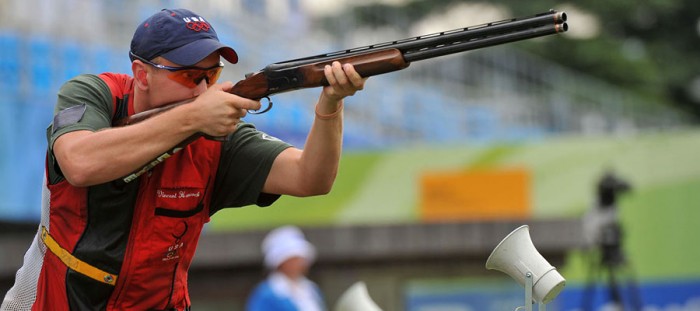The opening ceremony begins in a few hours. London’s Heathrow Airport has reported an increase of 47,000 daily passengers as spectators and athletes pour in from all over the world. In short, the 2012 Olympic Games are drawing near.
While we will certainly be watching as many of the events as we can, you can bet we’ll be glued to the TV during those sports closest to our hearts: shooting, archery, and equestrian. While we know that many of you are intimately familiar with these three sports, we thought it might be helpful to offer a quick overview of their structure for the rest of our readers.
Shooting:
The “shooting” heading actually encompasses 10 separate events, including a range of distances, shooting positions, and targets. In pistol and rifle events, competitors either shoot a specified number of shots at a stationary target within a certain time limit, or they may shoot at targets that briefly face the competitor and then turn away (example: Women’s 25m pistol).
As a way of engaging the audience, many of these events include a preliminary round and a final round. The preliminary round typically has a fairly large field and allows shooters to follow their own rhythm. Because it is often difficult for observers to follow the progress of this stage, a smaller field advances to a final round. In these final rounds, an official dictates the rhythm of the shooting. In each of these competitions, the scores from the preliminary and final rounds are totaled, and the winner is the competitor with the highest score.
On the shotgun side, events include trap, double trap, and skeet. In each of these events, competitors must shoot at moving clay targets. The machines that launch these targets are positioned at specific distances and are designed to launch the targets at a range of heights, angles, and speeds. Like their pistol and rifle counterparts, shotgun events often have final rounds composed of a smaller field. In these final rounds, the clay targets are often filled with powder that makes it easier for spectators to see when a target is hit.
Archery:
Unlike shooting events, archery in the Olympics includes both individual and team events. In both event styles, the distance from the archer to the target is 70 meters. Additionally, both styles are run in a tournament style with higher seeds facing lower seeds (much like NCAA basketball tournament).
In the individual competitions, 64 archers compete. The preliminary round begins with each archer shooting 72 arrows. They are then ranked by score and seeded for the single-elimination bracket. Once the bracket has been set, archers compete in head-to-head rounds with both archers simultaneously shooting 18 arrows, with the winner advancing. Once the field has been narrowed to eight archers, the format changes to 12 arrow matches with archers alternating by arrow.
In the team competitions, the same three individuals who compete for a country in the individual competitions compete as a team in a similar tournament style. Ranking is determined by combining the individual rankings from the individual competition. Matches consist of each team firing 27 arrows, with the winning team advancing to the next round.
Equestrian:
Equestrian at the Olympics includes three events–dressage, jumping, and eventing–with each event awarding both individual and team medals.
In the dressage competitions, the focus is on a horse and rider’s ability to perform a series of predetermined movements. Often considered the “ballet” of equestrian events, the top competitors successfully execute their movements smoothly and with incredible precision. Scores are assigned by a panel of judges who evaluate each competitor based on a number of factors, including the quality of the horse’s movement, the horse’s attention and confidence, and the rider’s seat and position.
The second equestrian event, show jumping, requires horse and rider to complete a series of 10 to 16 obstacles, with heights up to 1.6 meters and spreads up to two meters. Scoring is computed by calculating the number of faults each competitor sustains during the competition. Faults can be assessed for knocking down an obstacle, refusing to jump over an obstacle, and for exceeding the pre-determined time limit. The competitor with the best score (fewest number of faults) is the winner.
The last equestrian competition, eventing (or horse trials), is arguably the most grueling. Combining dressage, cross-country, and show jumping, the competition evaluates a horse and rider’s training, fitness, and ability to perform graceful and precise movements. The cross-country segment of eventing requires competitors to complete a long outdoor circuit composed of 30-40 obstacles. Scoring for eventing is based on a combination of time, faults, and judges’ evaluations.
Now that you can confidently call yourself an expert on these competitions, we are eager to know which competitors (both human and equine!) you’ll be following during these Olympics!

